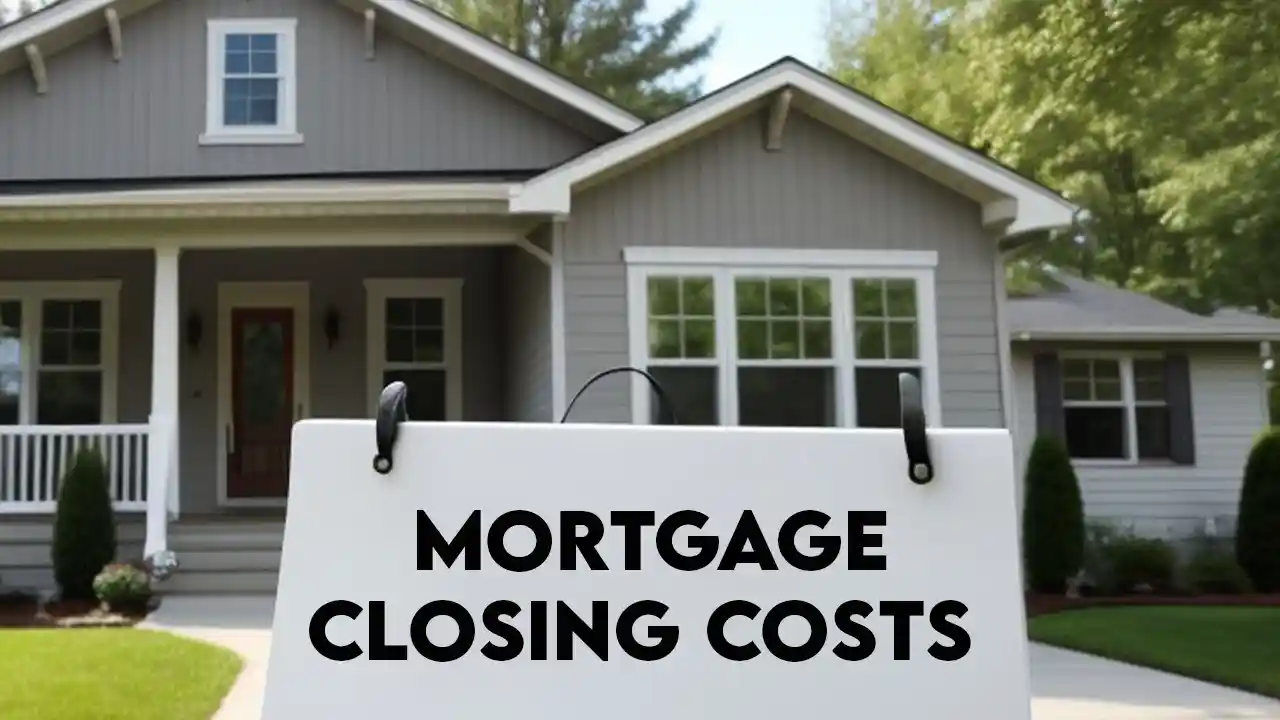Mortgagerateslocal.com – Buying a home is one of the most exciting and rewarding decisions you can make in your life. But it also comes with a lot of expenses, especially when it comes to closing the deal. Mortgage closing costs are the fees and charges that you have to pay to finalize your home loan.
They can include appraisal fees, title insurance, origination fees, taxes, and more. Depending on the type and size of your loan, your location, and your lender, closing costs can range from 3% to 6% of the loan amount. That means, for a $300,000 loan, you could pay anywhere from $9,000 to $18,000 in closing costs.
That’s a lot of money, right? But don’t worry, there are ways to reduce your closing costs and save some cash. We we will show you how to understand, negotiate, and avoid some of the closing costs that come with buying a home.
We will also give you some tips on how to budget and plan for these expenses, so you don’t get caught off guard. By the end of this post, you will have a better idea of how to save money on mortgage closing costs and make your home buying process smoother and easier.
What are mortgage closing costs and what do they cover?
Mortgage closing costs are the fees and charges that you have to pay to the third parties involved in your home purchase and loan process. These third parties include your lender, your real estate agent, your attorney, your appraiser, your title company, and your local government. They provide various services and products that are necessary to complete your home loan and transfer the ownership of the property to you. Some of the common closing costs are:
- Appraisal fee: This is the fee that you pay to the appraiser who evaluates the value of the home you are buying. The lender orders the appraisal to make sure that the loan amount does not exceed the property value. The appraisal fee can vary depending on the size, location, and condition of the home, but it usually ranges from $300 to $500.
- Origination fee: This is the fee that the lender charges for processing and underwriting your loan application. It covers the cost of verifying your income, credit, and assets, as well as preparing the loan documents. The origination fee is usually a percentage of the loan amount, typically between 0.5% and 1%.
- Discount points: These are optional fees that you pay upfront to the lender to lower your interest rate. One discount point equals 1% of the loan amount. For example, if you pay one point on a $300,000 loan, you will pay $3,000 at closing. In exchange, the lender will reduce your interest rate by a certain amount, usually 0.25%. Paying discount points can save you money in the long run if you plan to stay in the home for a long time and benefit from the lower monthly payments.
- Escrow account funds: These are the funds that you deposit into an escrow account that is managed by a third party, usually the title company. The escrow account holds the money that is used to pay for your property taxes and homeowners insurance premiums throughout the year. The lender requires you to fund the escrow account at closing to ensure that these payments are made on time and avoid any liens or penalties on the property. The amount of escrow funds you need to deposit depends on the timing and amount of your tax and insurance bills, but it can range from a few hundred to a few thousand dollars.
- Title insurance: This is the insurance that protects you and the lender from any defects or errors in the title of the property. A title company will conduct a title search to verify the ownership history and legal status of the property, and issue a title insurance policy that covers any potential claims or disputes that may arise. There are two types of title insurance: lender’s title insurance and owner’s title insurance. The lender’s title insurance is required by the lender and covers the amount of the loan. The owner’s title insurance is optional but highly recommended, as it covers the full value of the property. The cost of title insurance varies by state, loan amount, and property value, but it can range from $500 to $2,000.
- Recording fee: This is the fee that you pay to the local government to record the transfer of the property title and the mortgage lien. The recording fee covers the cost of filing and maintaining the public records of the real estate transaction. The recording fee varies by county and state, but it usually ranges from $50 to $250.
- Transfer tax: This is the tax that you pay to the state and/or local government when you buy or sell a property. The transfer tax is based on the sales price or the assessed value of the property, depending on the state. Some states have no transfer tax, while others have high transfer tax rates. For example, in Washington D.C., the transfer tax rate is 1.1% for properties under $400,000 and 1.45% for properties over $400,000. That means, for a $300,000 property, you would pay $3,300 in transfer tax in D.C.
- Real estate agent commission: This is the fee that you pay to the real estate agents who represent you and the seller in the home sale. The commission is usually a percentage of the sales price, typically 5% to 6%, and it is split between the buyer’s agent and the seller’s agent. For example, if you buy a $300,000 home with a 6% commission, you and the seller will each pay $9,000 to the agents. However, in most cases, the seller pays the entire commission, and the buyer does not have to pay anything to the agents. This is because the commission is deducted from the seller’s proceeds at closing, and the buyer’s agent gets paid by the seller’s agent.
How to negotiate and lower your closing costs
One of the best ways to save money on closing costs is to negotiate with the seller, the lender, and the third parties to reduce or waive some of the fees. Here are some tips on how to do that:
1. Ask the seller to pay for some or all of the closing costs
This is a common practice in a buyer’s market, where the supply of homes exceeds the demand, and the sellers are more motivated to sell. You can make an offer that is lower than the asking price, but includes a request for the seller to pay for some or all of the closing costs.
For example, you can offer $290,000 for a $300,000 home, but ask the seller to pay $10,000 in closing costs. This way, you can save money upfront and lower your loan amount. However, this strategy may not work in a seller’s market, where the demand for homes exceeds the supply, and the sellers have more bargaining power. In that case, you may have to compete with other buyers who are willing to pay the full price or more, and the seller may not agree to pay for any closing costs.
2. Shop around and compare different lenders
Different lenders may charge different fees and rates for the same loan product. Therefore, it is important to shop around and compare different loan estimates from different lenders. You can use online tools and calculators to compare the total cost and monthly payments of different loans.
You can also ask the lenders to match or beat the offers from other lenders. By doing this, you can find the best deal and save money on closing costs and interest.
3. Negotiate with the lender to waive or reduce some of the fees
Some of the fees that the lender charges may be negotiable or optional. For example, you can ask the lender to waive or reduce the origination fee, the application fee, the processing fee, the underwriting fee, the credit report fee, and the discount points.
You can also ask the lender to waive the escrow account requirement, which means you will pay for your property taxes and homeowners insurance on your own, instead of depositing money into an escrow account. However, this may result in a higher interest rate or a higher loan amount. You should weigh the pros and cons of each option and choose the one that suits your needs and budget.
4. Negotiate with the third parties to lower their fees
Some of the third-party fees may also be negotiable or variable. For example, you can ask the title company to lower the title insurance premium, the appraisal company to lower the appraisal fee, the attorney to lower the legal fee, and the real estate agent to lower the commission.
You can also shop around and choose your own third-party providers, instead of using the ones that the lender or the seller recommends. However, you should make sure that the lender approves of your choices and that the quality and service of the providers are satisfactory. You should also check the reviews and ratings of the providers before hiring them. By doing this, you can save money and avoid any problems or delays in the closing process.
How to avoid unnecessary or excessive closing costs
Another way to save money on closing costs is to avoid paying for services or products that you don’t need or that are overpriced. Here are some tips on how to do that:
- Review the loan estimate and the closing disclosure carefully: The loan estimate and the closing disclosure are two documents that the lender must provide you before and at closing. The loan estimate shows the projected closing costs and other loan details, while the closing disclosure shows the final closing costs and other loan details. You should review these documents carefully and look for any errors, discrepancies, or changes. For example, you should check if the interest rate, the loan amount, the loan term, the monthly payment, and the closing costs are the same as what you agreed to. You should also look for any fees that are not explained or justified, or that seem too high or unnecessary. If you find any issues, you should contact the lender and ask for clarification or correction. You have the right to dispute any charges that you think are unfair or inaccurate.
- Ask for a breakdown of the fees: Some of the fees that the lender or the third parties charge may be lumped together under vague or generic names, such as “administrative fee”, “processing fee”, “document fee”, or “miscellaneous fee”. These fees may include multiple items that are not specified or itemized. You should ask for a breakdown of these fees and find out what they cover and how they are calculated. You may be able to negotiate or eliminate some of the items that are redundant or unnecessary. For example, you may not need to pay for a courier fee if you can use email or fax to send the documents, or you may not need to pay for a pest inspection if the home is new or in good condition.
- Avoid buying optional products or services: Some of the products or services that the lender or the third parties offer may be optional or not required by law. For example, you may not need to buy owner’s title insurance if you trust the title company and the title search, or you may not need to buy mortgage insurance if you have a large down payment or a low loan-to-value ratio. You should weigh the benefits and costs of these products or services and decide if they are worth it or not. You should also be aware of any sales pitches or pressure tactics that the lender or the third parties may use to persuade you to buy these products or services. You have the right to decline or shop around for any optional products or services.
- Avoid paying for discount points if you don’t plan to stay in the home for a long time: Discount points are fees that you pay upfront to the lender to lower your interest rate. They can save you money in the long run if you plan to stay in the home for a long time and benefit from the lower monthly payments. However, if you don’t plan to stay in the home for a long time, or if you plan to refinance your loan in the future, paying for discount points may not be a good idea. You may not be able to recoup the cost of the discount points before you sell or refinance the home. You should calculate the break-even point of paying for discount points, which is the number of months it takes for the savings from the lower interest rate to equal the cost of the discount points. You can use online calculators or formulas to do this. For example, if you pay one point ($3,000) on a $300,000 loan with a 4% interest rate, and the point lowers your interest rate to 3.75%, your monthly payment will decrease by $44. The break-even point is $3,000 / $44 = 68 months. That means, you need to stay in the home for at least 68 months (5.7 years) to make paying for the point worthwhile. If you plan to stay in the home for less than that, you should avoid paying for the point.
How to budget and plan for your closing costs
One of the worst things that can happen when you buy a home is to run out of money or face unexpected expenses at closing. To avoid this, you should budget and plan for your closing costs ahead of time. Here are some tips on how to do that:
- Save up for your closing costs: Ideally, you should start saving for your closing costs as soon as you decide to buy a home. You can use online calculators or formulas to estimate how much your closing costs will be, based on your loan amount, interest rate, location, and other factors. You should also add a contingency fund of 10% to 20% of the estimated closing costs, to cover any changes or surprises that may occur. You should aim to save enough money to cover your closing costs and your down payment, as well as any other expenses that may arise during the home buying process, such as moving costs, home repairs, or furniture purchases.
- Use your savings or assets to pay for your closing costs: The best way to pay for your closing costs is to use your own savings or assets, such as cash, stocks, bonds, or retirement accounts. This way, you can avoid borrowing more money or paying interest on your closing costs. However, you should be careful not to deplete your emergency fund or jeopardize your long-term financial goals. You should also check the tax implications and penalties of withdrawing money from certain accounts, such as IRAs or 401(k)s. You should consult a financial advisor before making any major financial decisions.
- Get a gift or a loan from your family or friends: Another way to pay for your closing costs is to get a gift or a loan from your family or friends. This can be a great option if you have generous and supportive relatives or friends who are willing to help you out. However, you should be aware of the rules and regulations that apply to this option. For example, you may have to provide a gift letter to the lender that states the amount and source of the gift, and that the gift does not have to be repaid. You may also have to pay taxes on the gift, depending on the amount and the relationship between you and the giver. If you get a loan from your family or friends, you may have to pay interest and report it as income. You should also make sure that you have a written agreement that specifies the terms and conditions of the loan, and that you can afford to repay it without affecting your relationship.
- Roll your closing costs into your loan: Another way to pay for your closing costs is to roll them into your loan. This means that you add the closing costs to the loan amount, and pay them off over time with interest. This can be a convenient option if you don’t have enough cash or assets to pay for your closing costs upfront. However, you should be aware of the drawbacks and risks of this option. For example, you will end up paying more interest over the life of the loan, and you will have a higher loan-to-value ratio, which may affect your interest rate, your mortgage insurance, and your equity. You may also have to pay a higher origination fee or a higher interest rate to the lender for this option. You should compare the costs and benefits of this option with other options, and make sure that you can afford the higher monthly payments.
Conclusion
Mortgage closing costs are the fees and charges that you have to pay to finalize your home loan and purchase. By following these tips, you can save money on closing costs and make your home buying process smoother and easier. You can also use the money you save to pay off your loan faster, improve your home, or invest in your future.




